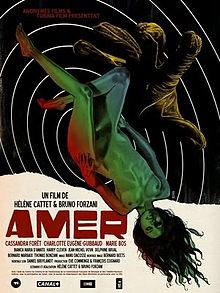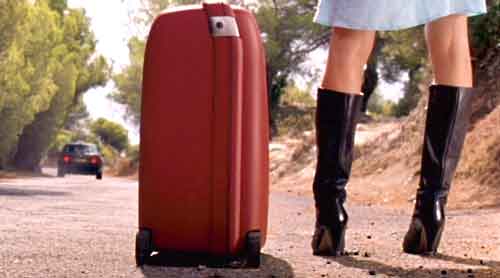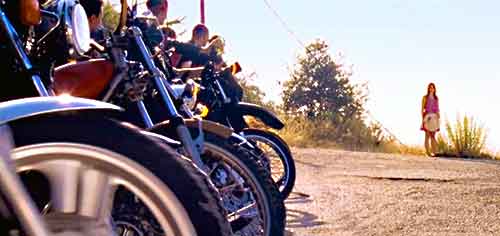 A tribute of sorts to the giallos of Dario Argento and a remarkable piece of hallucinatory filmmaking in its own right, AMER is among the most impressive foreign imports of the decade.
A tribute of sorts to the giallos of Dario Argento and a remarkable piece of hallucinatory filmmaking in its own right, AMER is among the most impressive foreign imports of the decade.
2009’s AMER, a France-Belgium co-production, was the first feature by the Belgian filmmaking team Helene Cattet and Bruno Forzani, who previously made three shorts (“Chambre Jaune,” “La Fin de Notre Amour” and “Santos Palace”). AMER was quite popular on the festival circuit, winning several prestigious awards, but (surprise!) got short-changed by U.S. distributors, playing but a single week in a few major cities during October of ‘10.
AMER was quite popular on the festival circuit, winning several prestigious awards, but (surprise!) got short-changed by U.S. distributors…
One night in her family’s cavernous, shadowy mansion, a little girl named Ana spies some deliriously odd, sexually tinged goings-on involving her parents, her deceased grandfather’s corpse, an old watch on a chain and a pet bird that doesn’t live very long.
Years later Ana, now a teenager, is wandering around a cliff-side retreat with her mother. The two become separated, and in a barbershop atop the cliff Ana encounters a young man who makes some mighty blatant sexual overtures; she rejects the advances, even though she finds herself unaccountably aroused. Ana is also intrigued by some burly bikers clustered a little farther down the cliff—where Ana’s mother abruptly turns up and slaps her for running off.
The beauty of the photography is undeniable, while the graphic violence of the final scenes, all presented in extreme close-up, is profoundly disquieting to watch.an
From there we jump forward several more years to adult Ana, who boards a taxi that takes her (once again) up a seaside cliff. Along the way she finds herself turned on by the gruff taxi driver and imagines her blouse ripping off to expose her breasts. She’s dropped off at a dark, seemingly abandoned castle, which, it gradually becomes clear, was where the events of the early scenes took place. Here Ana is stalked by a faceless maniac who wears black gloves and wields a nasty-looking straight razor.

With its incredibly garish color scheme, cacophonous soundtrack, gruesomely inventive bloodletting and all-around creepy aura, AMER credibly apes the look and feel of Dario Argento’s DEEP RED and SUSPIRIA. But it has a style and tone that are quite unique.
Slickly made yet highly experimental, it’s very much an ART film that’s more concerned with imparting a mood of erupting sexuality and impending menace than telling a linear story. There’s very little dialogue, with the directors Helene Cattet and Bruno Forzani largely allowing their highly expressive imagery—vines subtly caressing the heroine’s passing body, an ant crawling out of her belly button, the sharp edge of a razor slowly drawn across the surface of her skin—speak for itself.

I know some (okay, many) of you will despise the film, but I found it mesmerizing—and not a little unnerving. The beauty of the photography is undeniable, while the graphic violence of the final scenes, all presented in extreme close-up, is profoundly disquieting to watch. AMER overall, with its wildly hallucinatory air, is one of the most authentically dreamlike films I’ve seen, playing like a Dario Argento-inspired nightmare transposed intact to the screen.
Vital Statistics
AMER
Anonymes Films/Tobina Film
Directors: Helene Cattet, Bruno Forzani
Producers: Francois Cognard, Eve Commenge
Screenplay: Helene Cattet, Bruno Forzani
Cinematography: Manu Dacosse
Editing: Bernard Beets
Cast: Cassandra Foret, Charlotte Eugene Guibeaud, Marie Bos, Bianca Maria D’Amato, Harry Cleven, Delphine Brual, Jean-Michael Vovk, Bernard Marbaix

